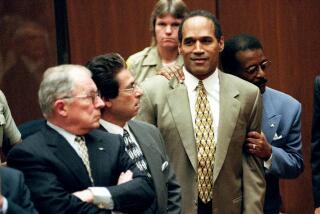For Jurors, Ordeal Goes Beyond the Courtroom
- Share via
The first weeks were the most hellish. The physical mutilations of young men, the castrations and tortures, the sexual perversions--all were introduced in the Santa Ana courtroom in pictures and testimony more brutally graphic than the 12 jurors and seven alternates could have ever imagined.
Those first few days and weeks, juror Alfred Embrey Jr. used to wake up in a cold sweat in his Orange home, the nightmares of violent crimes still fresh in his mind. An easygoing, 56-year-old electrician, he found himself strangely irritable with his wife. And later came the chest pains as he pondered whether Randy Steven Kraft of Long Beach should die in the gas chamber.
“When you’re not used to having to see things as brutal as this, it can be just too much to deal with,” Embrey said. “You have to block it out, put it aside; otherwise, it’s just too hard to accept that a human being could do this.”
A year after they were chosen, partly through luck of the draw, to judge a man reputed to be perhaps the most prolific serial killer in the nation’s history, the jurors’ official role in the Kraft case ended Friday in dramatic fashion with a death verdict that took just a single vote to reach.
But the effects of their ordeal extend far beyond the confines of the courtroom and promise to linger, for better or worse, for years.
“I know I can’t put this to rest,” said Jim E. Lytle, 29, of Garden Grove, who was the foreman of the jury for the two-month penalty phase of the trial. “It’s taken so much out of me.”
For some on the jury, the Kraft trial was a once-in-a-lifetime experience that, they say, has reshaped their lives positively by persuaded them to seek new careers in criminal justice or to pursue judicial reforms to speed the court process and strengthen the death penalty.
And Pat Marcantel, 37, of Fullerton added at the close of her year spent at the Orange County courthouse: “The food was great.”
But for many jurors, the memories were anything but sweet.
- A Brea schoolteacher came across the word “ligature”--something used for tying--in a lesson book and had to stop class momentarily because she was so shaken by the recurring images of Kraft choking young Marines with their own shoelaces.
“I remember I couldn’t catch my breath when I saw this word,” said teacher Charleen A. Vershaw of Brea. “I could never explain it to the children or to anybody else. Who would understand?”
- An Anaheim woman found an old green garbage bag in her garage and started crying uncontrollably. Inside was an old car transmission, but to the juror, the bag conjured up images of the one in which Randy Kraft had stuffed one of his victims.
“My husband and daughter asked me, ‘What’s wrong?’ ” said Debora Garcia, 31. “They don’t understand.”
And a Placentia housewife found that such household items as swizzle sticks, toothbrushes and shoelaces have now taken on a horrific meaning since the trial as Randy Kraft’s instruments of death and torture.
“I will never be the same,” said Theodora J. Replogle, 59, of Placentia. “Normal things don’t even seem to be the same anymore. . . . They were used so horribly by him.”
Echoing those thoughts, juror Carol M. Neal, 33, of Tustin said: “My husband came to court a few times so that he could see what I was going through. I just don’t think I’ll ever be the same again. I know I won’t be as trusting. I’ll know that someone who can seem very ordinary in everyday life can be capable of doing terrible things.
“I wouldn’t want to be alone. One night after we had viewed those awful pictures of (one of the victims), my husband was supposed to go bowling. But I asked him could he please stay home with me that night. I had to get my mind off it.”
The jurors, packed side by side in the Santa Ana courtroom of Superior Court Judge Donald A. McCartin, forbidden to discuss the case with anyone and sequestered for two weeks in a hotel in May to deliberate Kraft’s guilt or innocence, said they developed a close and unique bond.
“Everybody now knows everybody else’s life,” alternate juror Velma McClinton said. “Every year we’re going to have a reunion. It was like one big family.”
“We got to know each other better than we knew our own spouses,” Neal added.
When it was all over early Friday afternoon, when the verdict was read and the media people had asked all their questions and taken all their pictures, many of the jurors exchanged hugs and promised to keep in touch.
A few cried. Some went out together to get something to eat--a “relief lunch” at the end of a long ordeal, one called it.
They all seemed satisfied with the outcome.
Each had said, when the jury was being selected, that under the right circumstances they could sentence a defendant to death. But the actual delivery of such an extreme sentence, several said, was a far tougher matter.
“That’s something you have to give a great deal of thought, a great deal of soul searching,” said Corrine A. Goldfarb, 49, of Seal Beach.
The jurors took more than two days to reach a verdict of death, but they said most of that time was used to review the details of Kraft’s crimes: the 16 murders for which they convicted him in May and the eight additional killings that prosecutors introduced in the penalty phase of the trial.
Once that review was completed and the choice between death or a life without parole sentence was before them on Friday morning, the vote was quick and unanimous, jurors said.
Several jurors said they were generally unswayed by testimony from friends and family of Kraft, who portrayed him sympathetically. Kraft, the jurors believed, was a manipulative and deceitful person who was able to fool those close to him and hide behind a mask of respectability.
The jurors also said that despite attempts by the defense team to cast doubt on the character of the young men Kraft killed, they felt a real sympathy for the victims and their families, several of whom attended the trial.
“I felt like I knew the victims,” said juror Tracie Metzner, 26, of Santa Ana.
“We certainly didn’t go in there with ‘an eye for an eye’ mentality,” Embrey said, “but when we looked at the whole of the evidence, there was really only one possible conclusion: death.”
Jurors said the frequency of Kraft’s killings, the savagery of the crimes and the defendant’s apparent lack of remorse all contributed to their decision to send him to the gas chamber.
“The death phase was shocking to me,” Marcantel said. “Every time a new victim came up, he did something more horrible to them. I can’t imagine how somebody could do that to another person.”
As confident as the jurors said they were in their decision, many said that even after hundreds of witnesses and thousands of hours of testimony, they were still left with a nagging question. It was a question several said they wish they could put to Kraft himself: Why?
“How could someone look so normal and successful and then commit crimes as barbaric and inhumane as these?” Embrey asked. “I’m not sure we’ll ever know the answer.”
Times staff writers Jerry Hicks, Lily Eng and Mary Lou Fulton contributed to this story
FACTS ABOUT KRAFT TRIAL
Prosecutors: Two (Deputy Dist. Atty. Bryan F. Brown has been in charge of the case since Kraft’s arrest, assisted part-time by Deputy Dist. Atty. Thomas M. Goethals)
Defense attorneys: Three (James G. Merwin, C. Thomas McDonald and William J. Kopeny)
Judges: Five over six years. (Municipal Court judges Robert E. Thomas and John J. Ryan; Superior Court judges Luis A. Cardenas, James K. Turner, and Donald A. McCartin, the trial judge)
Evidence: About 2,500 pieces
Potential jurors interviewed: 350
Jury gender breakdown: 10 women and two men
Witnesses: More than 300.
Pages of transcripts: 27,000 (trial and pre-trial hearings)
Source: Clerk of Court
More to Read
Sign up for Essential California
The most important California stories and recommendations in your inbox every morning.
You may occasionally receive promotional content from the Los Angeles Times.










